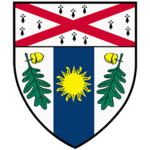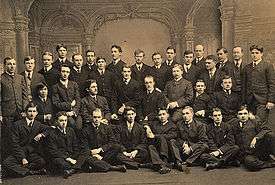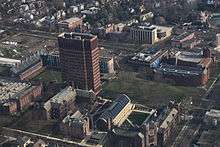Yale School of Forestry & Environmental Studies
| Yale School of Forestry & Environmental Studies | |
|---|---|
 | |
| Established | 1900 |
| Parent institution | Yale University |
| Location |
New Haven, Connecticut, United States 41°19′01″N 72°55′25″W / 41.31694°N 72.92361°WCoordinates: 41°19′01″N 72°55′25″W / 41.31694°N 72.92361°W |
| Dean | Indy Burke |
| Academic staff | 47 |
| Postgraduates | 280 |
| Doctoral students | 75 |
| Website |
environment |
The Yale School of Forestry & Environmental Studies (F&ES) is a professional school of Yale University. It was founded to train foresters, and now trains leaders through four 2-year degree programs and two 10-month mid-career programs. F&ES strives to creates new knowledge that will sustain and restore the health of the biosphere and emphasizes the possibility of creating a regenerative coexistence between humans and non-human life and the rest of the natural world. Still offering forestry instruction, the school has the oldest graduate forestry program in the United States.
History

The school was founded in 1900 as the Yale Forest School, to provide high-level forestry training suited to American conditions. At the urging of Yale alumnus Gifford Pinchot, his parents endowed the two-year postgraduate program. At the time Pinchot was serving as Bernhard Fernow's successor as Chief of the Division of Forestry (predecessor of the U.S. Forest Service, USFS). Pinchot released two foresters from the division to start the school: fellow Yale graduate Henry Solon Graves and James Toumey.[1] Graves became the School's first dean and Toumey its second.
When the school opened, other places in the United States offered forestry training, but none had a post-graduate program. (Both Pinchot and Graves had gone to Europe to study forestry after graduating from Yale.)[2]) In the fall of 1900, the New York State College of Forestry at Cornell had 24 students, Biltmore Forest School 9, and Yale 7.[1] Despite its small size, from its beginnings the school influenced American forestry. The first two chiefs of the USFS were Pinchot and Graves; the next three were graduates from the school's first decade. Wilderness and land conservation advocate Aldo Leopold graduated in the class of 1908.
In 1915, Yale School of Forestry's second dean, James Toumey, became one of the "charter members", along with William L. Bray of the New York State College of Forestry, by then reestablished at Syracuse University, and Raphael Zon, of the Ecological Society of America.[3] In 1950, the "activist wing" of that society formed The Nature Conservancy.[3]
Besides the school's own forests, Yale has used a number of other sites in the eastern United States for field education over the years. From 1904 to 1926, the summer session leading to a master's degree in forestry was held at Grey Towers and Forester's Hall in Milford, Pennsylvania.[4] Beginning in 1912, Yale classes took occasional field trips to the land of the Crossett Lumber Company in Arkansas. For two decades from 1946 until 1966, the company provided the school a "camp," including cabins and a mess hall, used during spring coursework on forest management and wood products production.[5] Yale students have also used a field camp at the Great Mountain Forest in northwestern Connecticut since 1941.[6]
The school changed its name to the Yale School of Forestry & Environmental Studies in 1972. The school's outgoing dean is Sir Peter Crane, the English evolutionary biologist who had served as Director of the Royal Botanic Gardens at Kew, London. A new dean, the school's 16th, was to be selected during the summer of 2016.
School buildings


The school offers classes at Kroon Hall, Sage Hall, Greeley Labs, Marsh Hall, the Environmental Science Center, the houses at 301 Prospect St. and 380 Edwards St., and teaches the Yale College undergraduate courses needed for the Environmental Studies major. Kroon Hall, the school's main building, is named for the philanthropist Richard Kroon (Yale Class of 1964). The building has 50,000 square feet (5,000 m2) of space. It is "a showcase of the latest developments in green building technology, a healthy and supportive environment for work and study, and a beautiful building that actively connects students, faculty, staff, and visitors with the natural world."[7] The building obtained Platinum Rating under the LEED certification system.[7] It is designed by Hopkins Architects of London with Architect of Record Centerbrook Architects.
Centers and programs
- Center for Biodiversity and Conservation Science
- Center for Business and the Environment at Yale
- Center for Environmental Law and Policy
- Center for Green Chemistry & Engineering at Yale
- Center for Industrial Ecology
- Environment and Health Initiative
- Global Institute of Sustainable Forestry
- Hixon Center for Urban Ecology
- Tropical Resources Institute
- The Yale Climate & Energy Institute
School forest
The school owns and manages 10,880 acres (44 km2) of forestland in Connecticut, New Hampshire, and Vermont. The Yale-Myers Forest, in Union, Connecticut, donated to Yale in 1930 by alumnus George Hewitt Myers, is managed by the school as a multiple-use working forest. Yale-Toumey Forest, near Keene, New Hampshire, was set up by James W. Toumey (a former dean of the school) in 1913. Other Yale forestlands include Goss Woods, Crowell Forest, Cross Woods, Bowen Forest, and Crowell Ravine.[8]
Student groups
The school has an active tradition of student involvement in academic and extracurricular life. Many students take part in student interest groups, which organize events around environmental issues of interest to them. These groups range in interest from Conservation Finance and International Development, to the Built Environment and "Fresh & Salty: The Society for Marine and Coastal systems". There are also social and recreational groups, such as the Forestry Club, which every Friday organizes themed "TGIF" ("Thank-God-I'm-a-Forester") happy hours and school parties; the Polar Bear club, which swims monthly in Long Island Sound under the full moon (year-round); Veggie Dinner, which is a weekly vegetarian dinner club; the Loggerrhythms, an a cappella singing group; and the student-run BYO Café in Kroon Hall opened in 2010.[9]
Notable graduates
- Alphonse "Buddy" Fletcher, Jr., class of 2004[10]
- Frances Beinecke, President, Natural Resources Defense Council; member, National Commission on the BP Deepwater Horizon Oil Spill and Offshore Drilling (2010)
- Richard M. Brett, conservationist
- William Wallace Covington, Regents' Professor, Northern Arizona University
- William B. Greeley, Chief, U.S. Forest Service, 1920–1928
- Stuart L. Hart, academic addressing global poverty and economic development, professor emeritus at Cornell University
- Ralph Hosmer, pioneering Hawaiian forester
- Edward M. Kennedy, Jr., 1991, attorney and Connecticut state senator
- Aldo Leopold, 1908, conservationist and author of A Sand County Almanac
- H. R. MacMillan, forester and industrialist
- John R. McGuire, Chief, U.S. Forest Service, 1972–1979
- Thornton T. Munger, pioneering U.S. Forest Service researcher; civic activist who helped create Portland, Oregon's Forest Park
- Mark Plotkin, ethnobotanist, explorer, and activist
- Robert Michael Pyle, lepidopterist and John-Burroughs-Medal–winning author
- Samuel J. Record, botanist
- Ferdinand A. Silcox, Chief, U.S. Forest Service, 1933–1939
- David Martyn Smith, forester and educator, author of The Practice of Silviculture
- Robert Y. Stuart, Chief, U.S. Forest Service, 1928–1933
See also
- François André Michaux laid the foundation for American forestry with his monumental work, The North American Sylva { akin to John James Audubon "The Birds of America"}starting in 1811.[11][12]
References
- 1 2 Sparhawk, W.N. (1949). "The History of Forestry in America". Trees: Yearbook of Agriculture. Washington, D.C.: United States Department of Agriculture. p. 710. Retrieved 28 March 2014.
- ↑ Pinchot, Gifford (1998). Breaking New Ground. Island Press. p. 152.
- 1 2 http://esa.org/history/
- ↑ "National Historic Landmarks & National Register of Historic Places in Pennsylvania" (Searchable database). CRGIS: Cultural Resources Geographic Information System. Note: This includes Steiner, Ben; Husson, Leon; Helfrich, Carson O. (December 1982). "National Register of Historic Places Inventory Nomination Form: Forester's Hall" (PDF). Retrieved 2012-05-30.
- ↑ Darling, Jr., O. H.; Norman, Bill. "Yale Camp". The Encyclopedia of Arkansas History & Culture. Retrieved 28 March 2014.
- ↑ "History: About Us". Great Mountain Forest. Retrieved 28 March 2014.
- 1 2 "Kroon Hall". Yale School of Forestry & Environmental Studies. Retrieved 28 March 2014.
- ↑ "Yale School Forests". Yale School of Forestry & Environmental Studies. Retrieved 28 March 2014.
- ↑ Henderson, Drew (18 February 2010). "Kroon opens student café". Yale Daily News. Retrieved 29 January 2011.
- ↑ Faxon, Hilary (13 September 2007). "Alum's gift funds FES aid offerings". Yale Daily News. Retrieved 28 March 2014.
- ↑ NYPL Digital Gallery | Results
- ↑ "Thomas Nuttall - North American Sylva - First Edition". Bauman Rare Books. Retrieved 2012-11-01.
External links
| Wikimedia Commons has media related to Yale School of Forestry & Environmental Studies. |